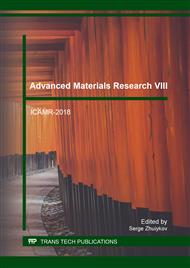p.232
p.237
p.243
p.249
p.255
p.260
p.269
p.275
p.280
Effects of Resin Coated Sand Mixture on Bending Strength and Cost
Abstract:
This research proposed a method to find out the relationship between bending strength of resin coated sand and the proportion of different types of sand and resin. It was figured out that Central Composite Design (CCD) was suitable to be used to save the number of experimental runs. Then, backward elimination regression analysis was used to determine the relationship equation of bending strength and proportion of different types of sand and resin. Next, optimization technique was applied to determine the optimal new setting, which provided any targeted level of bending strength with the minimal total cost of sand and resin. The results showed that the experimental results obtained from the CCD experiments provided the regression model, which had less than 6% error from the actual bending strength value. With this proposed method the total cost of sand and resin was reduced by 28.6% on average and it also provided the bending strength on any required target level.
Info:
Periodical:
Pages:
255-259
Citation:
Online since:
March 2018
Authors:
Price:
Сopyright:
© 2018 Trans Tech Publications Ltd. All Rights Reserved
Share:
Citation:


